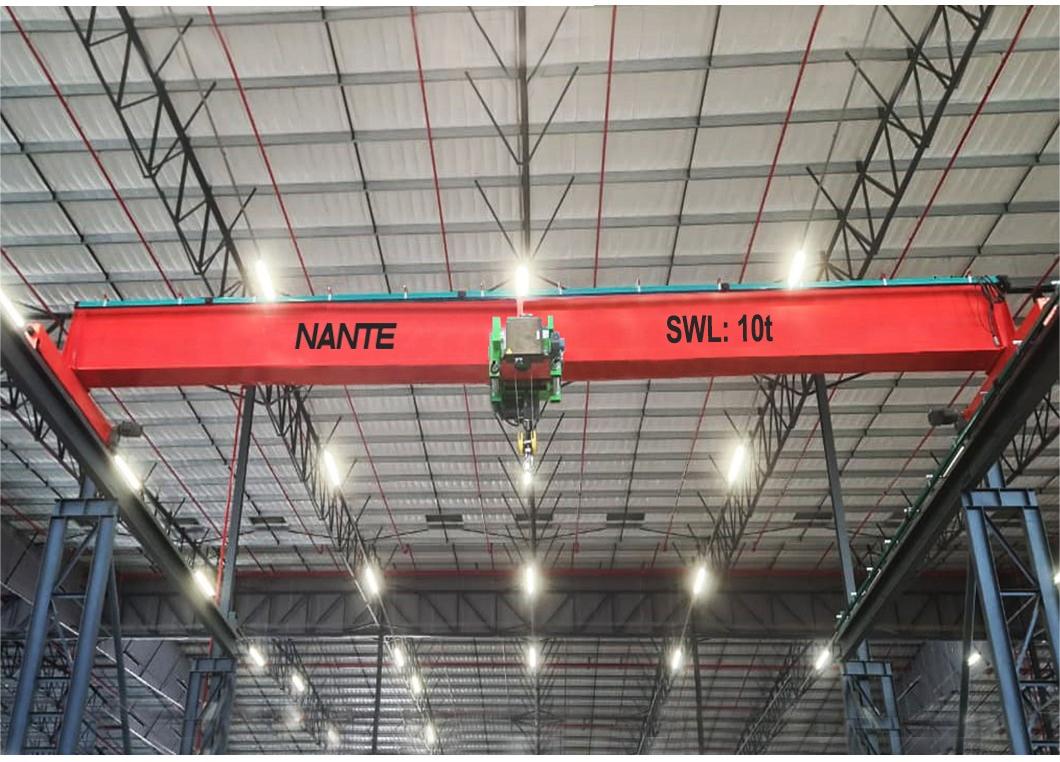7 Essential Functions of Overhead Chain in Modern Industry
Date: 2024-07-09 Share:
An Overhead Chain is a mechanical system designed to move items from one location to another along an elevated pathway. These chains are commonly utilized in various industries for their ability to transport heavy loads with ease and efficiency. They function by using a series of interconnected links or components that create a continuous loop, driven by motors or manual force. This setup enables the movement of goods without requiring significant ground space, making them an integral part of modern industrial operations.
The concept of the Overhead Chain has evolved significantly over the years. Initially, simple chain mechanisms were used to transport goods manually. However, with the advent of industrialization and technological advancements, these systems have become far more sophisticated. The introduction of powered overhead chains and automated control systems has revolutionized the way industries handle materials, leading to increased productivity and safety.

Key Functions of Overhead Chains
Material Handling
Transportation of Items in Manufacturing Plants
In manufacturing plants, Overhead Chains play a crucial role in the transportation of items. They are designed to efficiently move raw materials, components, and finished products across different stages of the production process. This seamless movement helps in maintaining a continuous production flow, reducing downtime, and ensuring that the manufacturing line operates optimally.
Warehousing Applications
Warehouses benefit immensely from the application of Overhead Chains. These chains enable the vertical and horizontal movement of goods, making it easier to manage inventory and optimize storage space. By using overhead systems, warehouses can tackle the challenges of space constraints and improve the efficiency of loading and unloading operations, thereby enhancing overall productivity.
As one of the famous brands in the production of winches, cranes and crane parts, Nante Crane is dedicated to research and development of lifting and material handling technologies. We adopt innovative ideas and design in developing new products and services. Backed up by a wealth of industrial experience, we can provide customers with high quality lifting equipment and components.
Safety Enhancement
Ensuring Safe Movement of Heavy Loads
One of the primary functions of Overhead Chains is to ensure the safe movement of heavy loads. Manual handling of heavy items can lead to workplace injuries and accidents. Overhead chains, on the other hand, are designed to handle significant weights with precision, reducing the risks associated with manual lifting and transportation. Their robust structure ensures that heavy items are securely moved without compromising safety.
Reducing Workplace Accidents
By incorporating Overhead Chains, industries can significantly minimize workplace accidents. These systems are engineered with safety features such as braking mechanisms and automated controls that prevent sudden movements and collisions. As a result, the incidence of accidents related to falling objects or manual mishandling is considerably reduced, fostering a safer working environment.
Efficiency Improvement
Speeding Up Production Processes
Overhead Chains are instrumental in speeding up production processes. By facilitating the rapid and seamless movement of materials, they eliminate bottlenecks and delays that often occur in manual transportation. This improved efficiency results in faster production cycles, enabling industries to meet their operational targets and customer demands more effectively.
Minimizing Manual Labor
Another significant advantage of Overhead Chains is the reduction in the reliance on manual labor. By automating the movement of materials, these systems free up human resources to focus on more complex and strategic tasks. This not only enhances productivity but also contributes to better job satisfaction and reduced physical strain on workers.
Common Applications of Overhead Chains
Automotive Industry
In the automotive industry, Overhead Chains are essential for assembly line operations. They enable the efficient movement of car parts and components across different workstations, ensuring a smooth assembly process. By streamlining logistics and material flow, overhead chains help manufacturers meet production deadlines and minimize downtime, making them a fundamental part of automotive manufacturing.
Food Processing Industry
The food processing industry utilizes Overhead Chains for tasks such as transporting ingredients, packaging, and moving finished products. Given the strict hygiene standards in this sector, overhead chains are designed with materials and coatings that are easy to clean and resistant to corrosion. This ensures the safe and sanitary handling of food products while optimizing the efficiency of processing lines.
Aerospace Industry
In the aerospace industry, where precise material handling is crucial, Overhead Chains are employed to move large and heavy aircraft components. These chains ensure the secure and precise transportation of parts such as wings, fuselage sections, and engines through various stages of assembly and inspection. The reliability and precision of overhead chains make them indispensable in maintaining the high standards required in aerospace manufacturing.
As one of the famous winch production and manufacturing brands, Nante Crane is committed to helping our clients reduce investment cost, improve production efficiency, and economize energy consumption. Nante Crane’s main products include industrial cranes, offshore cranes, Launching Crane, electric hoists, crane travel unit, mobile power supply system etc. with reliable and excellent performance.
Types of Overhead Chains and Their Uses
Enclosed Track Overhead Chains
Enclosed Track Overhead Chains are designed for light to medium-duty applications. The enclosed design protects the chain from dust and debris, making it ideal for clean environments such as electronics manufacturing or food processing. Its smooth operation and low maintenance requirements make it a popular choice for various industries.
Power and Free Overhead Chains
Power and Free Overhead Chains offer greater flexibility and control compared to other types. They consist of two tracks – one powered and one free. The powered track drives the movement, while the free track allows items to accumulate or divert as needed. This system is particularly useful in complex production lines requiring variable speeds and precise control over material flow.
Monorail Overhead Chains
Monorail Overhead Chains are commonly used in heavy-duty applications such as automotive and aerospace industries. They follow a single path and are capable of handling substantial loads. The simplicity of the monorail system ensures durability and ease of maintenance while offering a reliable solution for transporting heavy items.
Towline Overhead Chains
Towline Overhead Chains are used in assembly lines and warehousing operations where items need to be towed along a predetermined path. These chains are robust and are designed to handle continuous use, making them suitable for high-volume environments. The towline system’s ability to move items smoothly and efficiently makes it a valuable asset in any production or warehousing setting.
Choosing the Right Overhead Chain for Your Needs
Factors to Consider in Selection
Load Capacity
When selecting an Overhead Chain, it’s essential to consider the load capacity. The system you choose must be capable of handling the maximum weight of the items it will be transporting. Overloading can lead to mechanical failure and safety hazards, so understanding your specific load requirements is crucial.
Operational Environment
The operational environment plays a significant role in determining the right Overhead Chain. Factors such as temperature, humidity, and exposure to corrosive substances must be considered. For instance, environments with high moisture levels may require chains with corrosion-resistant coatings to ensure longevity and reliability.
Maintenance Requirements
Maintenance is another critical factor in selecting an Overhead Chain. Some systems require more frequent maintenance than others, impacting operational efficiency and costs. Understanding the maintenance needs and availability of spare parts can help you choose a system that aligns with your operational capabilities and ensures minimal downtime.
In addition to producing and manufacturing winches, Nante Crane has achieved breakthroughs in core technology and has the ability to manufacture core components, which are widely used in more than 20 professional fields such as advanced manufacturing, metal processing, aerospace, etc. Nante Crane is committed to the research and development and manufacturing of handling machinery and technology.
Maintaining and Inspecting Overhead Chains
Regular Maintenance Practices
Regular maintenance is vital to the longevity and optimal performance of Overhead Chains. This includes routine lubrication, tightening of components, and replacing worn-out parts. Scheduled maintenance checks help in identifying potential issues before they escalate, ensuring the system operates smoothly and efficiently.
Inspection Techniques and Schedules
Proper inspection techniques and schedules are necessary to ensure the safety and functionality of Overhead Chains. Visual inspections should be conducted regularly to check for signs of wear, misalignment, or damage. Additionally, periodic detailed inspections, including load testing and component analysis, should be performed by qualified professionals to maintain the system’s integrity and safety standards.
Future Trends in Overhead Chain Technology
The future of Overhead Chain technology looks promising with advancements in automation and smart technology integration. Innovations such as IoT-enabled monitoring systems, predictive maintenance analytics, and enhanced load management solutions are expected to drive efficiency and reliability further. These advancements will likely lead to more intelligent and self-sustaining overhead chain systems, reducing manual intervention and operational costs while enhancing productivity.
Frequently Asked Questions about Overhead Chains
What are the primary benefits of using overhead chains in industrial applications?
Overhead chains offer numerous benefits, including improved safety, increased efficiency, optimized space utilization, and reduced dependence on manual labor. They ensure the smooth and precise movement of goods, enhancing overall operational productivity.
How do I determine the right load capacity for my overhead chain system?
To determine the right load capacity, you need to understand the maximum weight your system will handle, including any potential overload scenarios. Consulting with an expert or referring to the manufacturer’s specifications can provide guidance tailored to your specific needs.
What maintenance practices are essential for overhead chains?
Essential maintenance practices include regular lubrication, tightening and inspecting components, and replacing worn parts. Adhering to a scheduled maintenance routine can prevent unexpected failures and prolong the lifespan of the system.
How can advancements in overhead chain technology benefit my operations?
Advancements in overhead chain technology, such as IoT-enabled systems and predictive maintenance, can enhance your operations by providing real-time monitoring, reducing downtime, and optimizing the efficiency and reliability of your material handling processes.
 English
English






